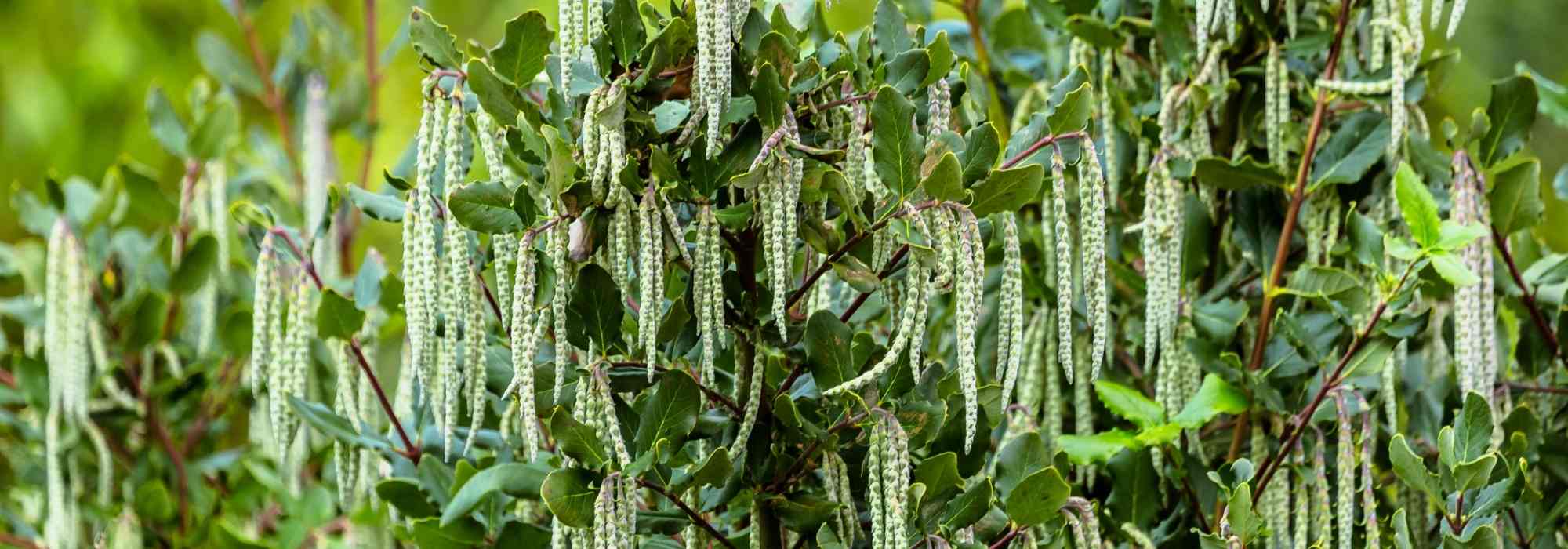
Garrya elliptica: planting, care
Contents
Garrya elliptica in a nutshell
- Garrya elliptica is one of the few bushes capable of flowering in winter, even in cold regions
- In mid-winter, it adorns itself with long, pendulous inflorescences in cream
- It is a medium-sized bush with beautiful evergreen foliage, double-coated in grey velvet
- Grow this marvel in full sun in the ground in our regions spared from harsh winters!
- With slow growth, this unique bush is well-suited for solitary planting or as a free-standing hedge
A word from our expert
Garrya elliptica is an evergreen bush with a fabulous winter flowering! In the heart of winter, its flowering with long pendulous cream-white aments awakens the garden still asleep from the cold and creates an extraordinary scene. Its evergreen foliage allows it to maintain a proud appearance throughout the year, making it suitable for a flowering hedge, in the midst of a shrub bed, or even as a standalone specimen. The Garrya elliptica ‘James Roof’ is perhaps the most beautiful cultivar of the genus, with its pink aments with silver reflections.
With a relative hardiness of -12°C, the Garrya elliptica is more accommodating in oceanic climates where it will thrive in full sun, in well-drained soil, well sheltered from severe frosts and cold winter winds.
Beautiful in every season, robust, it withstands diseases, pollution, and coastal conditions well. Pruning is not obligatory, but a short cutback of the stems at the end of winter will help it maintain a lovely shape.
Discover this spectacular bush that brings a refined and unique touch in winter, heralding the spring to come!
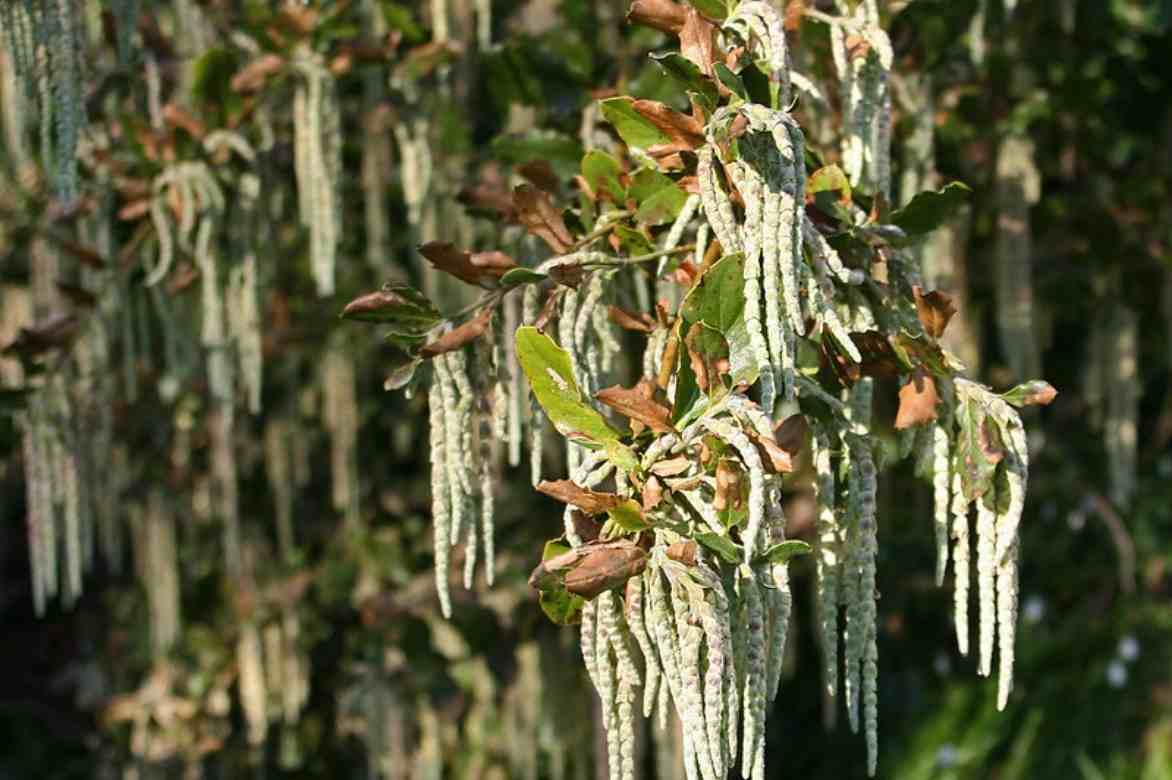
Garrya elliptica in flower in February (© Andrew Fogg)
Description and botany
Botanical data
- Latin name Garrya elliptica
- Family Garryaceae
- Common name Elliptical-leaved Garrya, coast silk tassel, bear bush, silky acorn garrya, quinine bush.
- Flowering December to March
- Height 2 to 3 m
- Exposure Sun, partial shade
- Soil type well-drained
- Hardiness -12°C
Garrya elliptica is an evergreen shrub from the Garryaceae family, native to the west coast of the United States. It can be found in the Californian coastal scrub and the northwestern region of Mexico, akin to our Mediterranean scrub, as well as in coastal sagebrush. It is a shrub suited to oceanic climates and thrives along our Breton or Atlantic coast.
The genus comprises about 15 species, among which Garrya elliptica, also known as “bear bush”, “silky acorn garrya”, or “quinine bush”, is the most commonly cultivated. It includes interesting male cultivars such as ‘Evie’ and ‘James Roof’.
With a rather slow growth rate, Garrya elliptica forms a bushy, compact, and somewhat irregular upright habit, rarely exceeding 2 to 3 m in height with a similar spread at maturity, which occurs around the age of 15 years. Its reasonable adult size makes it valuable in a small garden. In its natural habitat, it can reach up to 8 m in height in all directions. The highly branched growth often extends down to the ground. It displays evergreen foliage reminiscent of that of the holm oak. It dresses the garden with subtlety in mid-winter. The branches bear leathery leaves arranged oppositely. They are oval to elliptical in shape, measuring 4 to 8 cm in length, with smooth or undulating edges. Their shape has led to the shrub being sometimes referred to as “elliptical-leaved Garrya”. The leaves are grey-green to dark green and glossy, with a greyish, woolly underside and a lamina marked by lighter, prominent veins. Its leaves provide a wonderful contrast to the flowering.
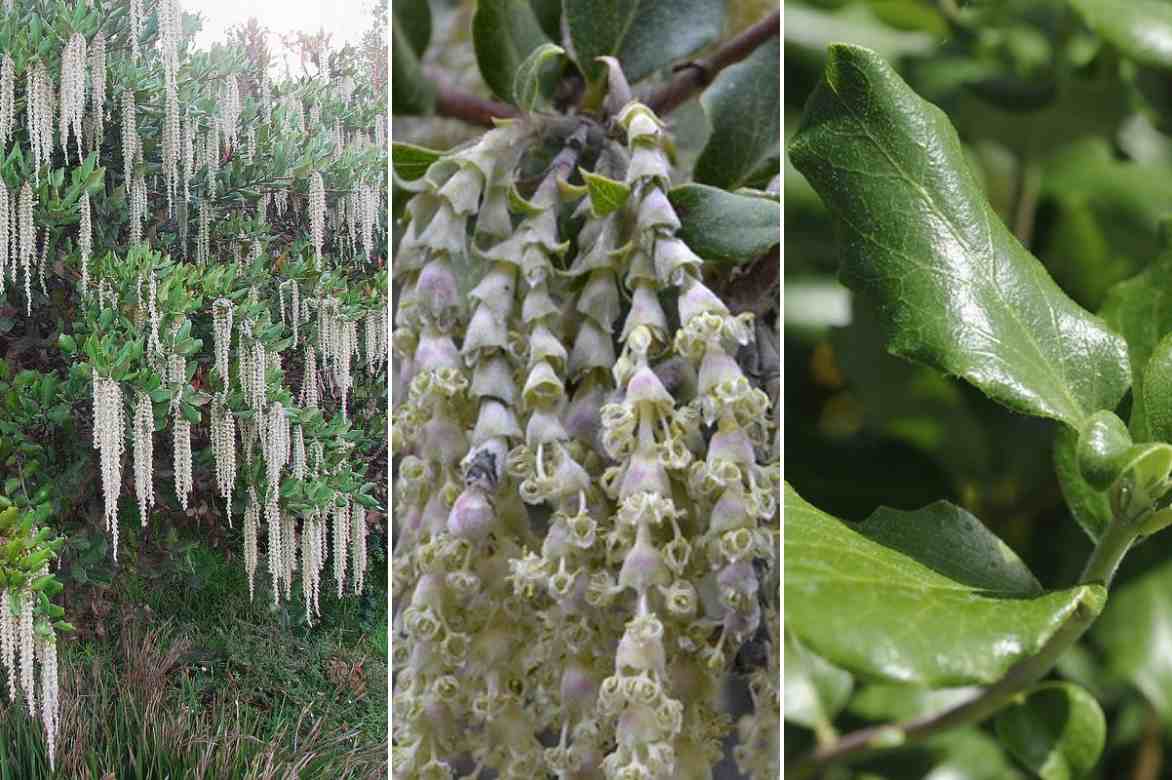
Garrya elliptica: winter flowering (© Sean O’Hara), close-up of the inflorescences (© Joe Blowe), and foliage (© Megan Hansen)
This shrub is valued for its spectacular and unusual winter flowering, remarkable for occurring in the midst of winter when the garden is at rest. It becomes covered in long, pendulous aments that are particularly decorative. Flowering occurs after 5 or 6 years of cultivation. It appears in January-February, sometimes as early as December, and continues until March-April depending on the region and climate. The Garrya elliptica is a dioecious shrub, meaning there are female and male individuals, distinguishable by the shape of their inflorescences.
The flowering of male plants is more spectacular due to the quantity of flowers, as well as their size. Male Garrya elliptica are distinguished by immense, drooping aments, while female plants bear shorter, upright flower spikes. These long, light spikes appear in the axils of the leaves and inevitably evoke stalactites swaying at the slightest breath of wind, or silky acorns for curtains, hence its English nickname “silk acorn of the coast”. These male aments measure from 7 to 40 cm in length, while those of female individuals are only 5 to 10 cm long.
These chains consist of small, petal-less flowers, stacked one above the other and enveloped in a silky bract. They bloom as small bells with yellow stamens, composed of 4 narrow, hairy sepals, cream to pink and then grey-silver at maturity in the typical species, white-pink-silver in its cultivar ‘James Roof’.
The pollen released by the flowers attracts pollinating insects in winter, particularly bumblebees that take advantage of this floral bounty to replenish their reserves.
Once fertilised, the female flowers produce small green berries, which turn black at maturity, containing 1 or 2 seeds. Fruiting only occurs in the presence of a male plant nearby.
Also known as “quinine bush”, the leaves and bark of Garrya elliptica contain substances effective against fever and were once used for their medicinal properties by Native Americans in decoction to combat malaria.
“`
Read also
How to prune early flowering bushesMain species and varieties
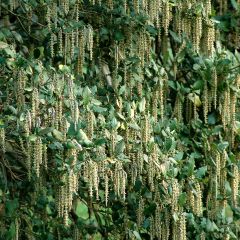
Garrya elliptica - Elliptical-leaved Garrya
- Flowering time March, April
- Height at maturity 3 m
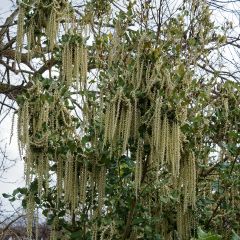
Garrya elliptica James Roof
- Flowering time February, March
- Height at maturity 3 m
Discover other Garrya
View all →Available in 1 sizes
Available in 2 sizes
Available in 1 sizes
Planting Garrya elliptica
Where to plant it?
With relatively low hardiness, around -10 to -12°C in a sheltered position, Garrya elliptica is easy to grow in regions where winters are relatively mild and dry, provided it is protected from severe frosts and dry, icy winds. In our area, it thrives in an oceanic climate, such as that of Brittany, on the western or south-western coast of our country. It tolerates sea spray. Compact, with relatively slow growth and good resistance to pollution, it will also adapt well in a warmer city garden that is better sheltered from cold winds than on the coast.
It prefers a sunny spot, especially along the coast, and more shaded areas inland or in our warmest regions. You can place it against a south- or west-facing wall, well sheltered to preserve the beauty of its aments. It should benefit from maximum light in winter to flower abundantly.
It grows in any ordinary soil, even calcareous, as long as it is well-drained at depth. In heavy or clayey soil, we recommend adding river sand and compost at planting. Once well established, it tolerates drought better.
The Garrya elliptica takes time to settle in and does not transplant well: choose a permanent location for it.
Its original silhouette should not be hidden: ideally, plant it in isolation in a clear area, or in a free hedge. It can also be planted in a grove at the back of a border, creating a spectacular focal point.
When to plant it?
Planting Garrya elliptica is best done in spring, in March-April, avoiding frost periods.
How to plant it?
If your soil tends to retain water and is clayey and compact, it is essential to add coarse sand, potting soil, and a handful of compost to the planting hole. For hedge planting, maintain a distance of 1 to 1.2 metres between each plant.
- Soak the root ball
- Dig a wide, deep hole that is three times the width of the root ball
- Add compost or leaf mould to the garden soil if it is clayey
- Add gravel to the bottom of the hole to ensure good drainage
- Create a small watering basin at the base of the shrub
- Water generously to ensure establishment
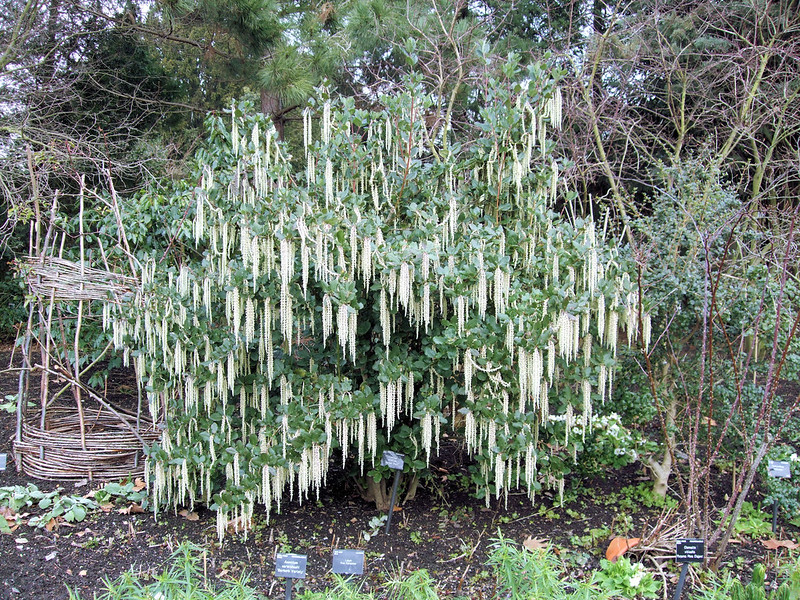
Garrya elliptica (© Jim Limwood)
Growing and care
Water regularly once or twice a week, especially during the first summer and in case of prolonged drought.
Mulch the stump with good organic mulch (dry leaves, straw, etc.) to keep its roots cool in summer and warm during winter, especially in cold regions.
Pruning is not necessary for this slow-growing shrub; a light cut back of the stems at the end of winter will help maintain a lovely shape and reduce any branches damaged by winter cold or that have finished flowering. Only intervene after flowering, in April for example, to remove any dead or poorly placed branches, to slightly limit its bulk and rebalance the shape. Be gentle, as overly drastic pruning can compromise future flowerings.
This shrub is resistant to most diseases. The foliage may occasionally show minor leaf spots.
Multiplication
Propagation by cuttings at the end of summer allows you to faithfully reproduce your shrub and renew older specimens. Layering is also possible.
When and how to take cuttings of Garrya elliptica?
- Take semi-woody or semi-ripe shoots 15 to 20 cm long
- Remove the lower leaves, keeping only two pairs of leaves at the top of the stems
- Plant the cuttings in pots, in a mixture of river sand and potting soil, or directly in the ground
- Keep these cuttings under a frame in the shade for the first 2 winters
- Maintain the substrate moist until rooting
- Transplant to the garden in spring, taking care not to disturb the young roots too much
Layering
- In summer, choose a shoot from the current year, located at the base of the plant
- Remove the flowers and leaves on the part of the stem to be buried
- Lay this shoot down towards the ground, burying it in a trench 10 cm deep that you have previously dug near the mother plant
- Hold the layer in the soil with a metal hook and fill with a mixture of sand and potting soil
- Raise the end of the layer by securing it with a small stake
- Firm the soil and water
- Separate the layer from the mother plant when it is sufficiently rooted
Pairing ideas
With its very unique silhouette and refined winter flowering, Garrya elliptica adds a touch of elegance and the unusual to the still bare garden. In a bushy mass, it can be paired with winter-flowering shrubs such as Hamamelis or spring-flowering varieties like Magnolia stellata, or Calycanthus or the Anemone Tree.
In an interesting flowering hedge all year round, place it near Euonymus myrianthus, a beautiful Chinese spindle with clusters of pale yellow waxy flowers, and Cotinus, which will take over the flowering.
At the heart of a shrub mass or even as a solitary specimen, it will be accompanied by an Leycesteria Formosa ‘Purple Rain’, the Pheasant Tree, and a Fuchsia magellanica ‘Hawkshead’ that will follow it beautifully.
Dress its base with a carpet of winter heathers, Hellebores, or early bulbs such as winter Aconites, daffodils, and crocuses to accompany it into spring.
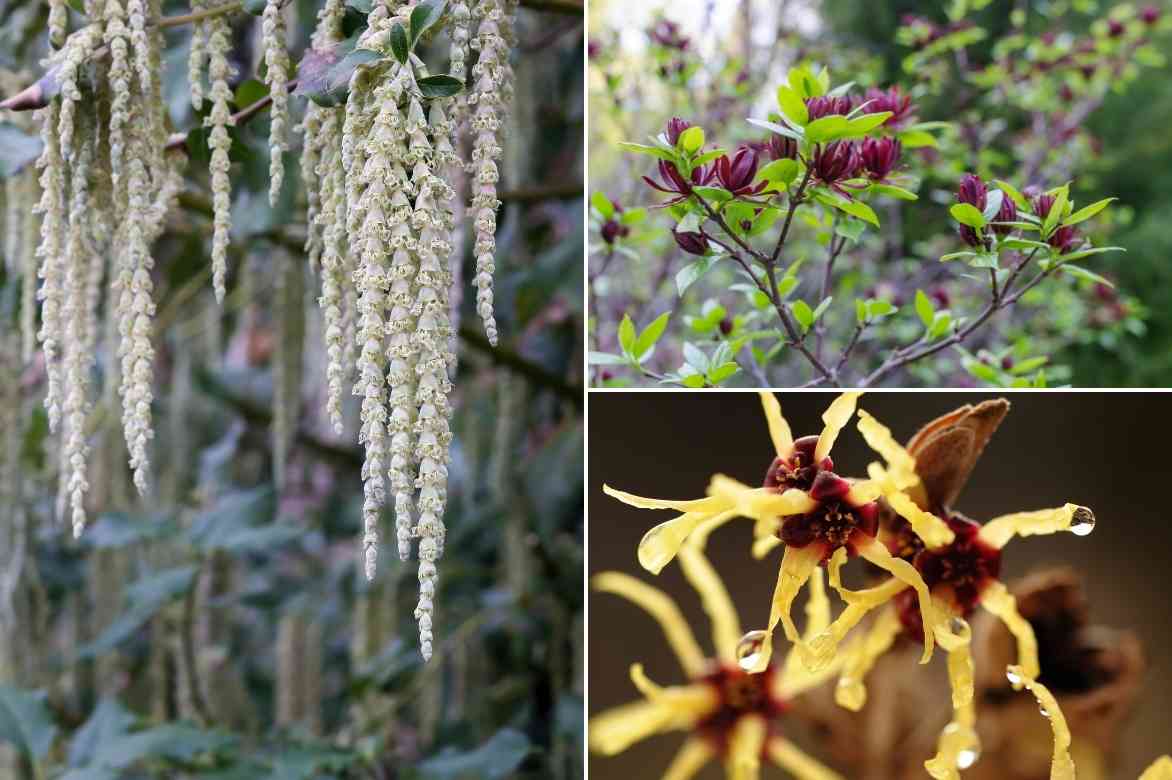
Association of winter-flowering shrubs: Garrya elliptica, Calycanthus, and Hamamelis
Useful resources
- How to liven up your garden in the dreary season?
- Discover Sophie’s article with more bushes with extraordinary flowers!
- Garrya: 4 ideas for successful combinations
- Subscribe!
- Contents

































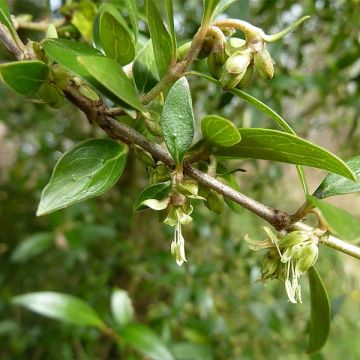
Comments